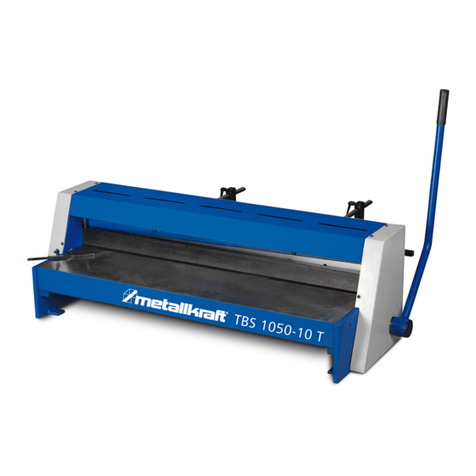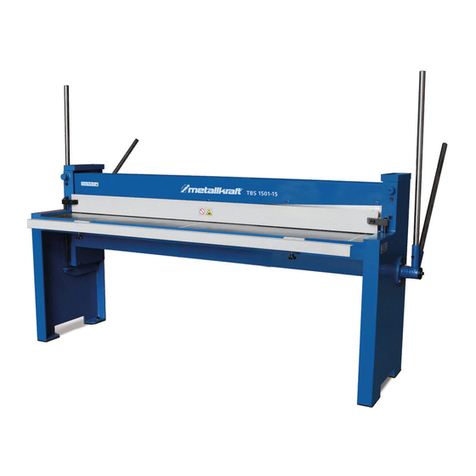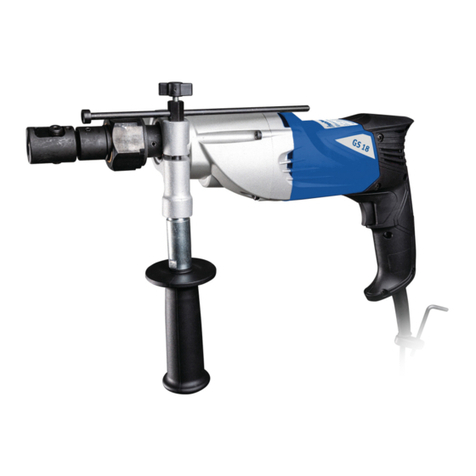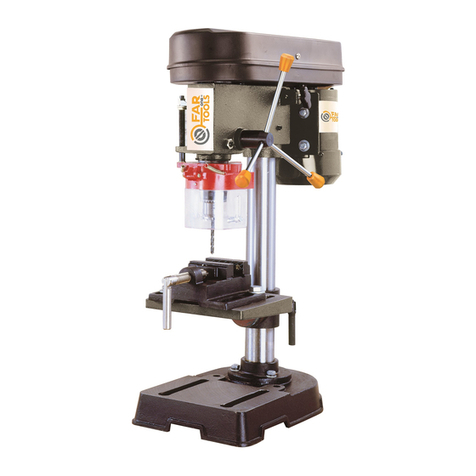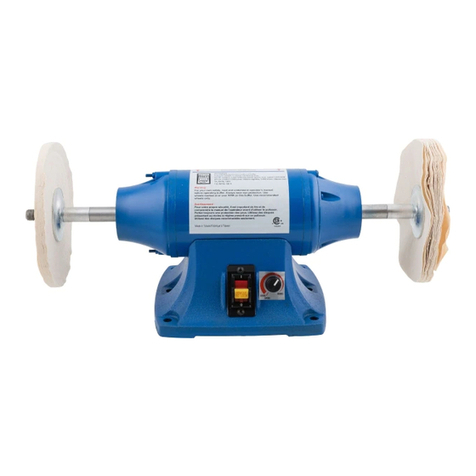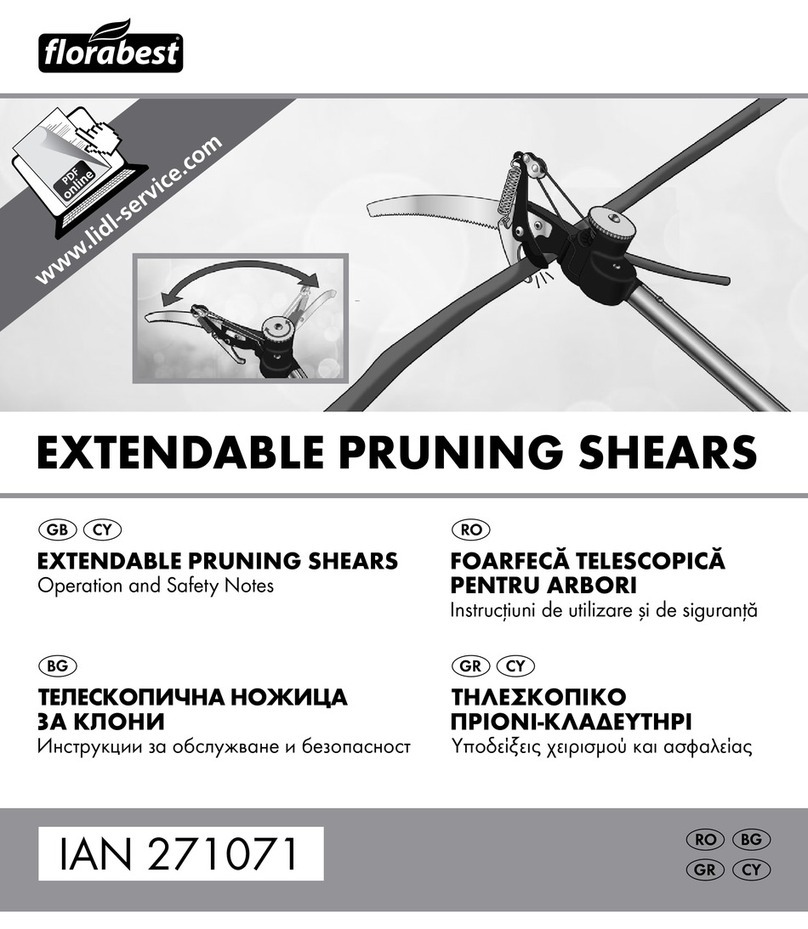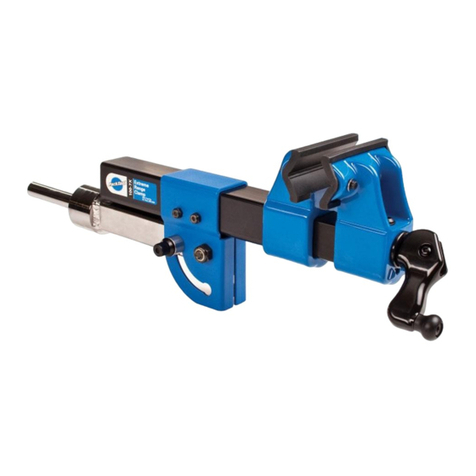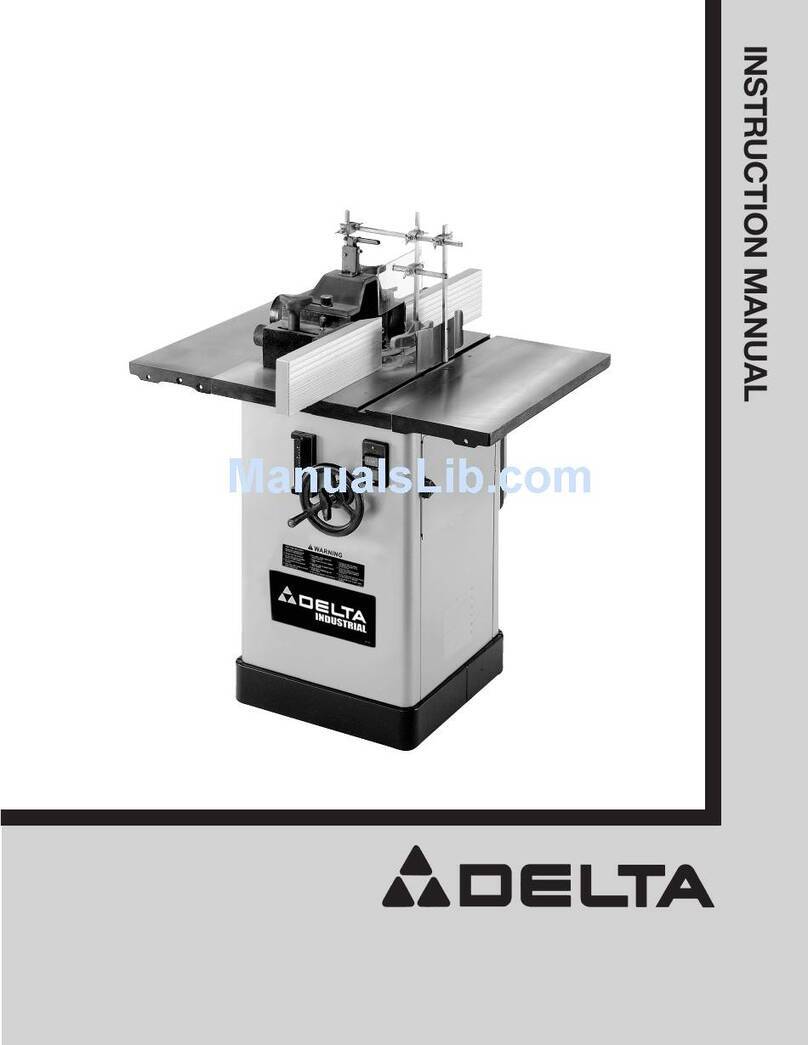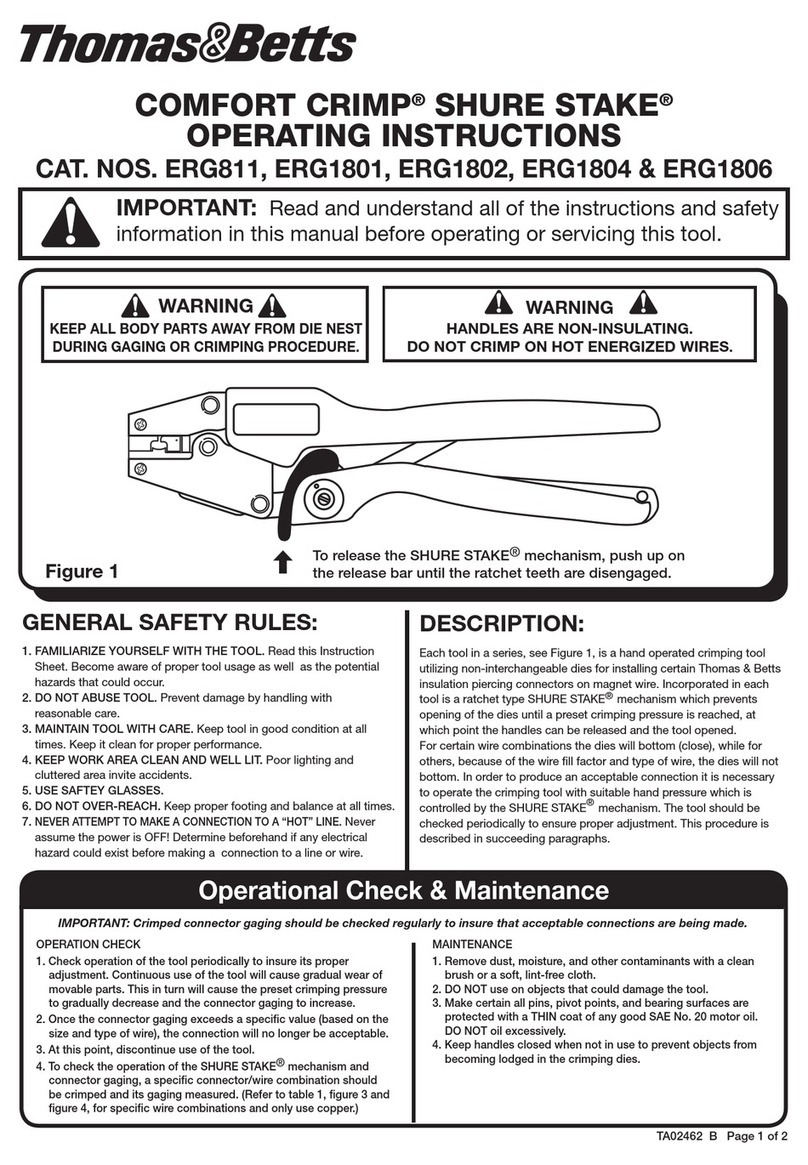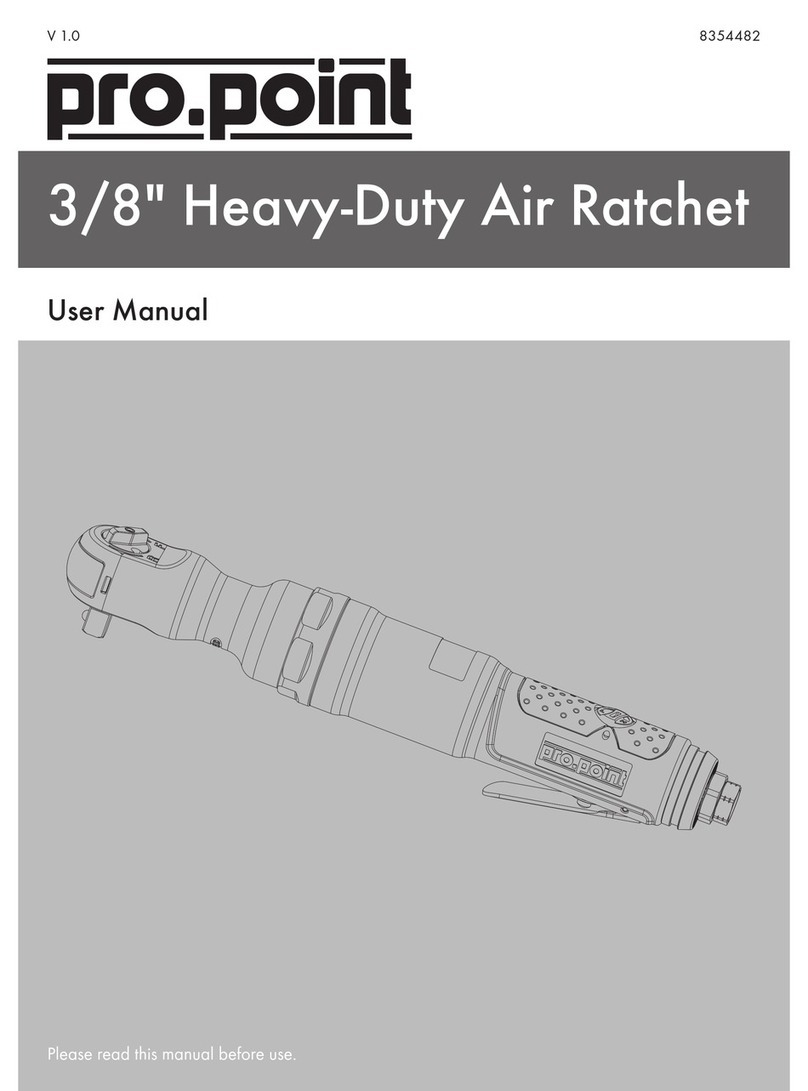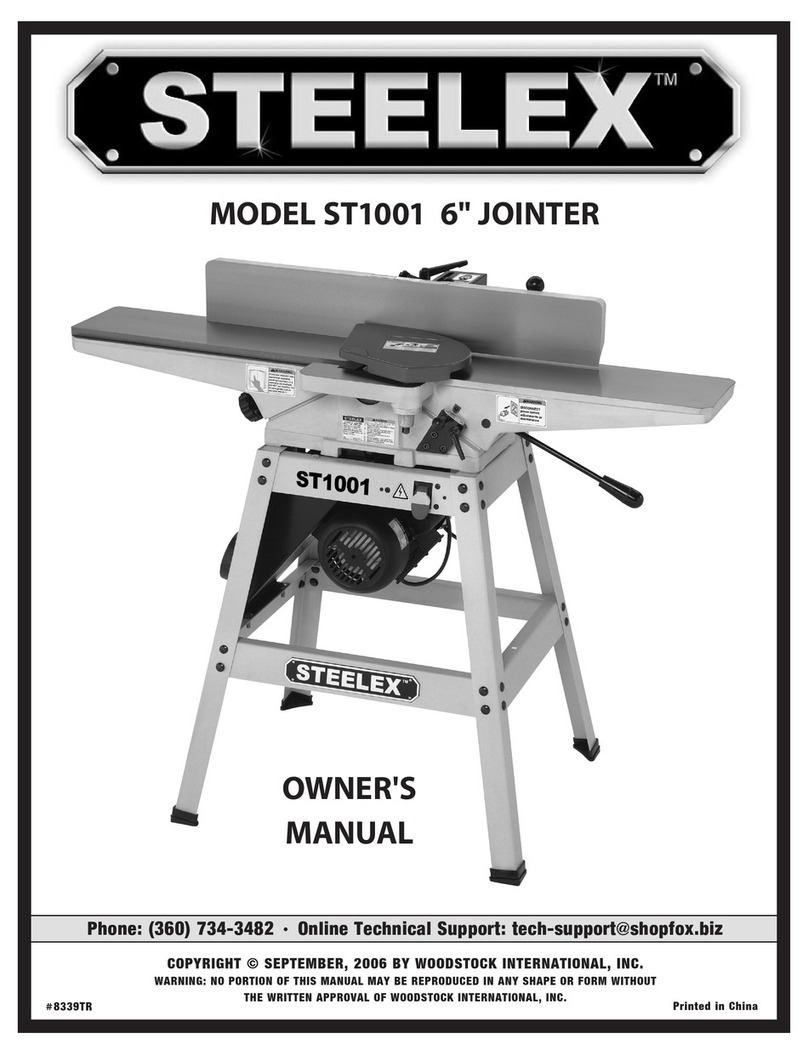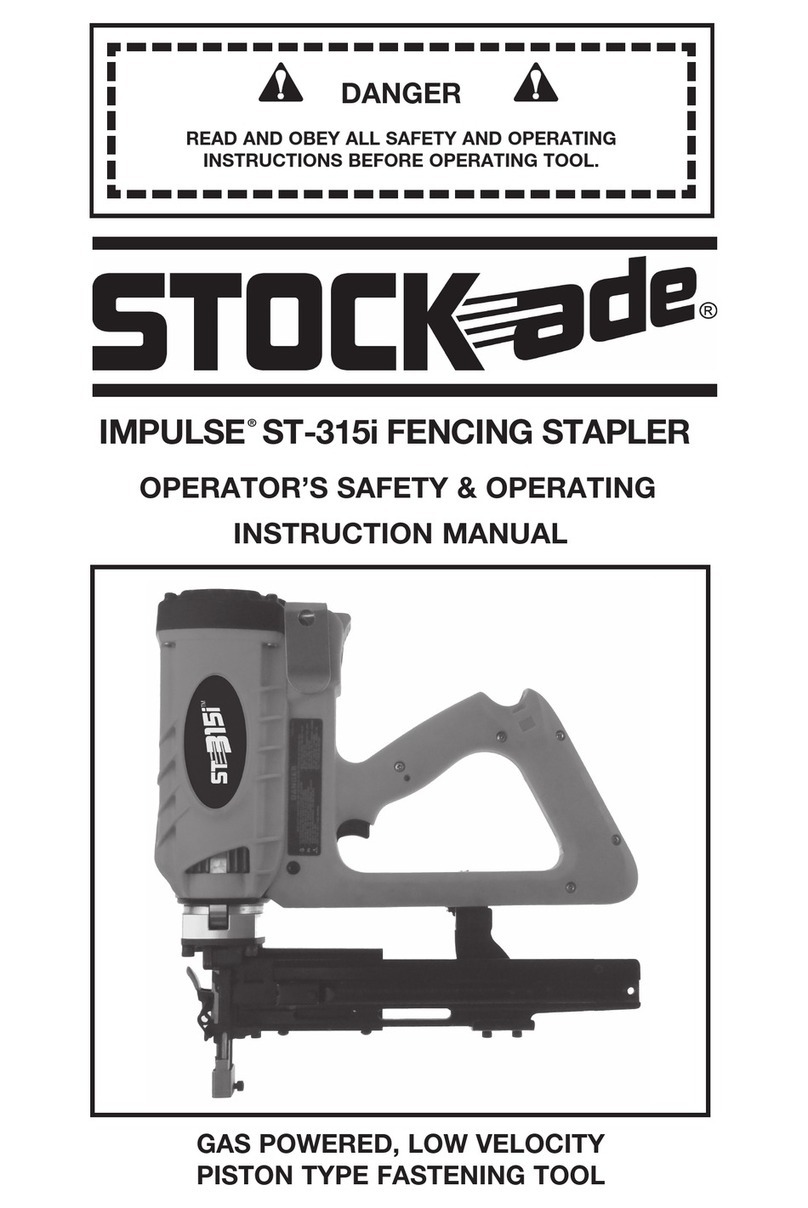Metallkraft HPS DS Series User manual

Operating Instructions
Hydraulic section steel shears
HPS 55 DS, HPS 65 DS, HPS 85 DS
HPS 115 DS, HPS 175 DS
HPS
DS
Series

INDEX Page
General notes 1-2
Readjustment 3
View of the delivery side 4
Setting up the machine 5
Technical specifications 6-8
Additional tools 9
Five work stations 10-11
Safety explanations 12-14
Operation of the machine 15
Arrangement of the punch tools 16-18
Safety precautions on each of the work stations 19
Angle cutting installation 20
Mitring angle 45 degrees 21
Profie cutting station 22
Shearing, profile section cutting 23
Notching station 24
Stroke adjustment 25
Hydraulic system 26-27
Machine rod and lever readjustment 28
Punch tools 29
Punch tool part list 30
Part and parts list of the cutting frame 31
Blade adjustment / blade change 32
Blade part list 33
Notching parts 34
Special accessories 35
True punching 36
Hydraulic plan 37
Transportation 38
EC Declaration of Conformity 39

- 1 -
GENERAL NOTES
1.
Introduction
Thank you for choosing a METALLKRAFT Metal Working Machine. We are proud to have you
in our long list of satisfied customers all over the world.
This User’s Manual is absolutely for your safety and is essential for the machine to have a
long production life. As long as you keep up with our Manual you will be able to run your machine
smoothly and safely. Keep in mind that the machine is designed absolutely to perform maximum
safety and for efficientworking.
In this Manual you can find instructions and information about:
Correct installations of themachine
Description of the functional parts of themachine
Set-up and start-upadjustments
Correct standard and scheduledmaintenance
Simple safety regulations and accidentprevention.
Therefore, as far as the user’s safety is concerned, in this handbook the possible risks con-
nected with machine operation are pointed out as follows:
Attention: Showing the risks of accident, if instructions are notfollowed.
Warring: Showing the probable damages to the machine or equipment, if the
instructions are not strictly followed.
Note: It gives usefulinformation.
It is certainly necessary that the operator should read and understand all the Attention,
Warring, Note specified in this Manual before starting with operation of the machine and before any
lubrication or maintenance intervention
On all steps of installation, operation and maintenance safety must be your first concern for
the protection of yourself, other users and the service of the machine. In case of any failure please first
refer to this Manual, and then if a solution cannot be found contact first of all the distributor where you
purchased our product. Do not forget to refer to the drawings and the numbers for any spare part
needed or to define any problem. Make sure you have the serial number and production year of the
machine.
Our technical staff will make their best to help you in the most convenient way.

- 2 -
2.
Transport
As soon as you receive the machine, check for any visible transport damages. Should there
be any visible damages; report it straight away to the transporter company and of course Stürmer
Maschinen GmbH or yoursupplier.
Remove any protective crates around the machine and read the instructions on related chap-
ters of this Manual carefully to set up the machine. If the machine is damaged while transport, imme-
diately take some photographs for insurance claims.
Take precautions while loading / unloading or moving the machine to avoid any injuries. Refer
also to related chapter of this Manual for the best way of handling the machine.
3.
Electrical Information
All necessary connection procedure can be found on this Manual. Do not try to connect the
machine before reading these procedures and fully understanding the drawings. For any unclear
matters get in touch with Stürmer Maschinen GmbH. Have the machine connected by a qualified
electric technician. For, as we made clear in the “general conditions of guarantee”, under no
circumstances installing mistakes, including electrical connection mistake, can’t be covered by
guarantee agreement. Always turn off power before making any connections or disconnecting the
machine.
4.
Maintenance
Your machine is designed and produced to work efficiently and smoothly. To achieve this you
should also take care while operating the machine. Regard Maintenance sections to have the longest
life from your machine. Try and use original spare parts where necessary and most importantly do not
overload the machine or do not make any unauthorized modifications.
5.
Safety
Take all precautions possible to avoid any personal injury while using the machine. Keep in
mind to protect the third party people around the machine. Refer to safety directives.

- 3 -
READJUSTMENT
The adjustment of the shear levers should be carried out before any adjustment of the shear blade. The
adjustment explain as shown below.
Explanation of figure
1.
Adjustment screw
2.
Safety nut
3.
Bronze pressureplate
1
3
2

- 4 -
Punch unit
Punch cylinder
Punch unit
Driver set hydraulic
VIEW OF THE DELIVERY SIDE
Lever group
VIEW OF THE EXIT SIDE

- 5 -
SETTING UP THE MACHINE
Ask for the help of an experienced and qualified technician while setting up the machine.
1)
Fundamental Plan of the Machine
Four holes (Refer to the drawing below) Dia.15mm
2)
Instructions
For an effective machine, the position and the base of the machine are important. Be careful
on these points while placing the machine:
The machine must be placed on a flat, preferably cement base. To fix the machine use bolts.
There must be plenty of room all around the machine for easyworking.
The machine height is ideal for anyworkingman.
There must be plenty of Light on top of themachine

- 6 -
TECHNICAL SPECIFICATIONS
General Information
HPS 55 DS HPS 65 DS HPS 85 DS
Motor Power 5,5 kW 5,5 kW 7,5 kW
Pressure 55 t 65 t 85 t
Operating Voltage 400 V/50 Hz 400 V/50 Hz 400 V/50 Hz
Machine Dimensions
L x B x H [mm] 1500 x 950 x
1880 1700 x 950 x
1880 1920 x 950 x
2040
Weight 1520 kg 1600 kg 2315 kg
Noise Level LWA 96,9 dBA 96,9 dBA 96,9 dBA
Notching
Thickness max. 10 mm 10 mm 13 mm
Width (L) 45 mm 45 mm 52 mm
Depth (P) 90 mm 90 mm 100 mm
Working height 900 mm 900 mm 940 mm
Sheet Metal Shear
Sheet thickness max.
200 x 20 mm 300 x 20 mm 380 x 20 mm
Sheet size max. 300 x 15 mm 375 x 15 mm 480 x 15 mm
Blade lenght 317 mm 380 mm 482 mm
Shearing with angle 80 x 15 mm 100 x 15 mm 120 x 15 mm
Working height 900 mm 900 mm 940 mm
Punching
Ø max. x Thickness Ø 100 x 3 mm Ø 110 x 3 mm Ø 110 x 4 mm
Ø x max. Thickness Ø 20 x 20 mm Ø 26 x 20 mm Ø 33 x 20 mm
Ø x Thickness Ø 40 x 10 mm Ø 57 x 10 mm Ø 57 x 12 mm
Stroke 60 mm 55 mm 80 mm
Stroke count (20
mm)
25 25 25
Throat depth 255 mm 305 mm 355 mm
Working height 900 mm 900 mm 9040 mm
Steel Bar Shearing
Round / Square Ø 40 / 40 mm Ø 45 / 45 mm Ø 50 / 50 mm
Angle Shear
Angle section 90° 120x120x12 120x120x12 150x150x15
Angle section 45° 70x70x10 70 x 10 80 x 8
Working height 1130 mm 1140 mm 1200 mm

- 7 -
General Information
HPS 115 DS HPS 175 DS
Motor Power 11 kW 11 kW
Pressure 115 t 175 t
Operating Voltage 400 V/50 Hz 400 V/50 Hz
Machine dimensions
L x B x H [mm] 2040 x 950 x
2180 2730 x 1150 x
2280
Weight 2920 kg 6000 kg
Noise Level LWA 96,9 dBA 96,9 dBA
Optional Tools HPS 55 DS HPS 65 DS HPS 85 DS
U-I Section blades 120 x 58 mm 120 x 58 mm 160 x 74 mm
T- Section blades 80 x 9 mm 90 x 11 mm 100 x 11 mm
V-notching
tooling[mm] 100 x 100 x 10 100 x 100 x 10 100 x 100 x 13
V-bending Press brake:
Bar bend max. 250 x 12 mm 250 x 15 mm 250 x 20 mm
Sheet bend max. 500 x 3 mm 500 x 3 mm 500 x 4 mm
Punching on
notcher:
Bar bend max. 125 mm 125 mm 125 mm
Capacity max. 38 x 8 mm 38 x 8 mm 38 x 10 mm
Punching
Ø max. x thickness Ø 110 x 5 mm Ø 125 x 5 mm
Ø x max. thickness Ø 34 x 26 mm Ø 40 x 32 mm
Ø x thickness Ø 55 x 16 mm Ø 57 x 22 mm
Stroke 80 mm 80 mm
Stroke/min (20 mm) 25 22
Throat depth 355 mm 625 mm
Working height 935 mm 1130 mm
Steel Bar Shearing
Round / Square Ø 55 / 50 mm Ø 65 / 55 mm
Angle Shear
Angle section 90° 150x150x16 200x200x20
Angle section 45° 80 x 10 80 x 10
Working height 1215 mm 1130 mm

- 8 -
Sheet Metal Shear
Sheet thickness max.
380 x 25 mm 380 x 30 mm
Sheet size max. 600 x 15 mm 600 x 20 mm
Blade lenght 610 mm 610 mm
Shearing with angle 120 x 15 mm 120 x 15 mm
Working height 935 mm 810 mm
Notching
Thickness max. 13 mm 16 mm
Width (L) 60 mm 60 mm
Depth (P) 100 mm 100 mm
Working height 935 mm 910 mm
Optional Tools HPS 115 DS HPS 175 DS
U-I Section blades 200 x 90 mm 300 x 125 mm
T-Section blades 120 x 13 mm 150 x 15 mm
V-notching
tooling [mm] 100 x 100 x 13 100 x 100 x 16
V-bending Press brake:
Bar bend. max. 250 x 22 mm 250 x 25 mm
Sheet bend. max. 700 x 3 mm 700 x 3 mm
Punching on
notcher:
Bar bend max. 125 mm 125 mm
Capacity max. 38 x 12 mm 38 x 13 mm

- 9 -
ADDITIONAL TOOLS
BENDING
Maximum bar size
PUNCHING AT THREADING STATION
Maximum capacity
Groove depth
NOTCHING
Maximum thread surface
PIPE NOTCHING
Maximum tube diameter
Based on material strength 45 [kg/mm2]
The maximum punching pressure of this machine is 650 kN ( 65 ton )
500x3 [mm2]
38x8 [mm2]
85 [mm2]
100x100x6 [mm3]
83 [mm]
The following tools are included in the basic equipment of the machine;
1 C – Spanner 80/90
3, 4, 5, 6, 8, 10, 14, 19 mm. Allenkeys
Punch adapter
Punch holder
Stamp and matrix (22mm)
Scraper
Round square blade (1 set)
Angle cutting blade (1 set)
Profile cutting blade (1set)
Notching tools

- 10
FIVE WORK STATIONS
1.
1-PUNCHING STATION
All punching operating are processed by means of hydraulic power thus giving the machine
the ability to punch very efficiently and silently. It can either be used to punch thick materials
or thin materials in layers together. Punching is silent, powerful and efficient. The waste
materials in layers together. The punching table consists two parts. First is the punching
flange. The second is holder. The holder is a device that holds the material after punching not
to come back with the punch. It must be equally adjusted or it can break the punch. There are
different holders for different materials. However the standard holder which we supply is
suitable for punching is between 6-38mm.
SAFETY PRECAUTIONS
All power and depth and other adjustment must be done under full control of an
experienced technician
Please check all the moving parts beforeworking
Check the punch and die that they are in the samedirection
Adjust the holder equally and according to thematerial
always use the protectiveplastics
on small and accuracy needing works use specialprotection
while replacing the punch or die or holder shut the mainswitch
never leave the machineunattended
do NOT overload the machine
2.
SHEARING STATION
The shearing unit has been equipped with a simple and robust fixing installation, which can be
adjusted for any material thickness within the cutting the cutting capacity of the machine. A
shearing up to 450 for flat bars or the cutting of the flanges of angle profiles, which have
previously been cut at inclined-angle cutting stations.
The shearing blades constructed for mass production can be used on both sides ( the upper
blade has 2 cutting edges, the lower blade has 4 cutting edges ) and ensure a clean cutting
with the minimum deformation, from the full capacity till a material thickness of only 2 mm.
SAFETY PRECAUTIONS
Always use the bolder
Never place any part of your body under theblade
Do NOT overload themachine
3.
CUTTING STATION
This station enables the cutting of big angles with a capacity of up to 900 and smaller angles
up to 450. The angle between 450and 900 will be obtained, these will be cut first at 900and then
at the shearing station of the flange will be cut at the required angle. The fixing installation
supports the material in a manner to provide a correctcutting.
SAFETY PRECAUTIONS
Never place your hand or fingers inside theblade.
Do NOT overload themachine
Use holder fitted on this station for a betterwork

- 11
4.
PROFILE CUTTING STATION
The machine are equipped as standard with the blades for cutting round and quadrangle bars.
Through additional equipment, it is possible to cut at the machine U-section, I-section and T-
section profiles in this clearance. The blades are held by simple squeezing jaws which ensure
an easy equipment arrangement at the machine without any detailed adjustment.
SAFETY PRECAUTIONS
Never place your hand or fingers inside theblade.
Do NOT overload themachine
Use holder fitted on this station for a betterwork
5.
NOTCHING STATION
The notching station has been equipped as standard with a rectangle unit and threading table
having adjustable counter holders, which enable a repeatable positioning. Additional
installations are available for narrow widths or V notching of angles up to 450 (V). Furthermore,
it is possible to have units for forming at bar ends and for easy notching works.
SAFETY PRECAUTIONS
Never put any part of your body under theblade
Use protective gloves or protective cages for very smallworks
Do NOT overload themachine
SHOWS OF THE FIVE WORK STATIONS
STANDARD SPECIFICATIONS
Punch and dieØ22
Punchholder
Flange cuttingblade
Notchingblade
Centralizedlubrication
Crescentkey
User'smanual

- 12
SAFETY EXPLANATIONS
The Machine is equipped with a hydraulic check valve system in order to relieve the excess
pressure when the machine is overloaded, thus preventing serious damage to the machine and the
worker. All safety precautions are for your safety, which we believe will be obeyed by our customers
unasked.
SAFETY UNITS
Quick stop button use on the panel and mainbody
Protective barriers
In this manual are summarized the important information for work safety. The following
security explanations and instructions are considered as the essential information for your safety.
Any and all persons who must operate the machine should be firstly trained well in terms of the
operation and safety information and instructions. For this purpose, more copies of this manual shall
always be asked from the supplier. It should be clearly fixed out that which persons will have the
responsibility to change and arrange tools and blades. These persons need to be essentially trained
in terms of this subject.
All the METALLKRAFT machines are delivered as standard with a safety equipment,
such equipment is for a high and general work safety. For this purpose, the machine should only be
used in accordance for those purposes for which it has been constructed.
The most dangerous and probable deviations as to the construction limits of the
machine are estimated to be as follows:
1.
Machining of other materials as unalloyed steel (45kg/mm2)
2.
Erroneous use of the fixinginstallation
3.
Punching or fixing very small work pieces, as these will easily cause the operators be subject
to danger zones.
Should the additional tools be necessary to be used on the machine, which are not foreseen
by the producer, it should be re-verified whether or not there is sufficient safety and security against
work accidents. For this purpose, the producer should be contacted for advice when deemed
necessary. All the maintenance works should be carried out by sufficiently qualified expert personnel.
Particular attention should be paid to the correct assembly and arrangement of the hole stamps,
cutting cases, blades and other tools. In order to enable us and yourselves to fulfill our mutual and
common responsibility for all people, we request you to read this manual very carefully before putting
the machine into operation and to obey all the safety information andinstructions.
Attention: All the parts of the machine dyed in red are danger zones and particular
attention should be paid in such zones!
All the operators should be instructed in order not to place their fingers or other body parts
near, in or under the parts of the machine colored in red. There is the risk of losing the body parts
when these are placed in suchzones!

- 13
All the safety components and fixing installations that should be removed for maintenance
purposes, should be remounted again before the machine is reoperated. The operators should wear
the clothing described by the employer. The producer recommend the use of protection eyeglasses
against eventual stamp breaks and shoes with steel covering in order to prevent foot of the operator
against falling materials.
SAFETY RULES
1.
The assembly and adjustment works, tool changes and maintenance services shall only be
realized by the technical personnel qualified for this purpose, who should strictly obey the
instructions of the producer.
2.
Remove any oil remaining, cuttings and other impurities from the working zone where such
remaining might be left the previousoperator.
3.
Before the starts working on the machine, the operator should make sure that all the tools are
in a perfectcondition.
4.
Any leakage and order of hole stamps and cutting cases, blade tolerances etc. should be
checked after each tool change and be readjusted ifnecessary.
5.
The scraper should always be adjusted according to the material resistance to be machined.
Unequal scraping forces can easily result with toolbreaks.
6.
Never punch any material which stronger than the diameter of the hole stamp. In this case, the
hole stamp can be overloaded and easilybreak.
7.
Always punch trough holes. Never punch base holes, unless the tool is clearly foreseen for
this purpose. The lateral elongation force, which occurs during punching of the base holes,
might excessively press the hole stamp against the cutting case and consequently an easy
break might result.
8.
The machine has been designed in a manner to work with the pieces which can be placed
without having subjected the fingers or hands into the danger zone. For punching, mortising
and profile cutting of the short pieces ( for instance small sheet metal parts ), special tools,
scrapers and security components are pieces should be placed into the machine and taken
back suitable holding tools.
9.
Regularly check the screw connections and other fixings of all the blades and other parts as
well as the safe seating of the hole stamp and cutting cases. For example, should the hole
stamp ( punch ) get loose during the operation, there occurs the danger that the hole stamp
inclined over the cutting case so that the tool mightbreak.
10.
Before each tool change, make sure that the machine is disconnected from mainswitch.
11.
Completely disconnect the machine from the net before you carry out any maintenancework.
12.
Never let the machine function without anyinspection.

- 14
13.
When you perform works where big forces are existing, the work piece should be additionally
protected through a block having an assembled roll or similar installation, which is to be
placed on the machine.
14.
The machine capacity shall never be exceeded. For this purpose, check the" technical data"
on this rules and compare the values with the information given on the manufacture plate. All
the capacity information is based on a material having a resistance of 45kg/mm2
15.
Should the hydraulic circuit flow be overloaded, the hydraulic oil will be led back to the reserve
tank over the overload valve until the pressure gets down again to the normallevel.
Attention: HOWEVER, IT IS. NECESSARY TO UNDERLINE THAT IT MIGHT BE
DANGEROUS TO USE THE OVERLOAD VALVE AS A "SAFETY VALVE" IN ORDER TO
EXCEED THE MACHINE CAPACITY.
The producer presents all the instructions for a work protection and safety and hopes to have
a good and full calibration with you, the users, in order to ensure that the maximum Level of safety
could be obtained.
CONTROLS BEFORE PUTTING INTO OPERATION
1.
Press on the green " START " button in order to start the machine. In order to ensure this,
make sure that the red off button (" STOP") rotates clockwise (or directly todraw).
2.
Make sure that the entries for hole stamp and cutting case are safetyfixed.
3.
At the command table, change the status from "NORMA" to "ADJUSTMENT" ( Consider that
the readjustment course is not automatic at this position. When you leave the foot pedal
loose, the machine does not return to standby, rather it simply getsleft).
4.
Make sure that the course limiter allows a maximum course. Now, press on the foot pedal so
often that the hole stamp stays in the cutting case. Take care that the hole stamp is regularly
arranged with the cuttingcase.
5.
Change the position from “ADJUSTMENT” to “NORMAL” at the command board. Now the
machine gets automatically back to the standbyposition.
6.
Check whether or not single cylinder perform, full course. Make sure that, no-hydraulic pres-
sure occurs at the and of related course. In order to ensure that there is no air available in the
hydraulic system, repeat the process several times (air might enter here during transport).
7.
Verify all tubes, hoses connections, branching and reserve tank for eventual hydraulic
leakage.
8.
Fix again all the protection parts and remove all loose subjects from the working zone of the
machine
The machine is now ready for your job.

- 15
OPERATION OF THE MACHINE
Operation elements
All the electrical delivery of the machine passes through the main switch. In order to connect
this, rotate the switch clockwise. To confirm this, check that the control lamp starts lighten.
By pressing on the green “START” button, connect the motor (for the motor to be able to
function, the “STOP” button should be disconnected. This can be realized by rotating the red button
clockwise (or drawing this).
By pressing on the red “STOP” button, the motor will be stopped. The lightly pressed “STOP”
button gets locked at command. In order to loosen the button and to cause the machine to function
again, the “STOP” button will be turned clockwise ( or drawn ).
Note: The machine has two
pedals and double pistons. We
designed two workstations to work at
the same time; two operators can
make two operations at the same
time.
The pedal switch has three positions:
Over position
central position
lower position
If pedal is driven till the lower position and there remains fixed, the machine gets into the
deepest punching position. Nevertheless, the machine doesn’t turn back to the standby position until
the pedal is left loose.
The central pedal position allows the operator to effect unlimited positioning including over and
down course. This central position is very practical because it allows the operator to carry out touching
so that the work piece can be optimally positioned.
The switch “NORMAL / ADJUSTMENT” ensures that the machine is operated at touch
operation or performs production at normal functioning.
When the switch is arranged on “NORMAL”, the machine performs a normal and full work
cycle at each action of the foot pedal, that means the punch moves to the lowest position and then
gets again into thestandby.
When the switch is arranged to “ADJUSTMENT” the
machine stops. When the pedal is left loose, the automatic
back course at this position has been cancelled.
REGULAR LUBRICATION INSTALLATION
The machine is equipped with a central lubrication
pump under pressure which is located at used, the system
should be adjusted to a pressure of 1-3 bars. When the
machine is at operation, a suitable pressure would be
maintained, through which the system will get back into the
previous filling pressure (approximately each 30 to 60
minutes).

- 16
ARRANGEMENT OF THE PUNCH TOOLS
IN GENERAL
The big punch bearing surface and the
removable front block have been constructed in
manner to allow a very wide range punch works:
Through the optionally obtained tools, the
big holes in any form up to the diameter / quadrate
as it is indicated in the capacity table can be
produced. In addition, machining at overhanging
position, with the removed front in addition, during
machining at overhang, with the removed front
block, the of U profiles of double T supports having
diameters or eventually diagonals up to 38mm
highest capacity can bepunched.
The punching stamp is held though a
holding ring, according to the size of the stamp
(punch) one or two of the delivered adapters can be
used. The matrixes are fixed to the tensioning plate
through a positioning screw. When the filled punch
stamps and matrixes are be arranged, it should be
paid attention to the screw is correctly placedon
the machined surface of the matrix. In order to allow
a suitable play area and to ensure that the material
is taken out, the punch stamp scraper plate should
be correctly adjusted, however it should not effect
the stamp course. Attention should be paid to that
the lower course limiting switch has been adjusted
as per the instructions. When the holes are punched
with sufficient material, a flat contact occurs at both
sides of the scraper plate. The scraper forces can
be important and unbalanced scraper forces can
lead to the break of the punch stamp through the
contact with a side of thescraper.
No material should be punched which is
thicker than the stamp diameter. The quality of the
hole is a direct finger appearance on the situation of
the punch stamp and matrix.
When the scraper fingers are used for very
big holes or irregular forms, the fingers should be
equally position and adjusted in order to prevent and
unbalanced scraper load.
Additional tools at this multi purpose work
station allow bar and sheet metal bending works,
edge threading, tube threading, tube threading and
general column positioning works.

- 17
In order to install or change the punch tools you will need the following tools:
Hook key
Soc. head cap bolt key ( 6 mm )
Screw key ( 24 mm )
WHILE ORDERING SPARE STAMPS AND MATRIXES, PLEASE ALWAYS INFORM OF THE
FOLLOWING: MODEL, TYPE AND MANUFACTURING NUMBER OF THE MACHINE.
Below we explain step by step now the hole stamp and cutting case are changed:
1)
In order to take out the cutting case, move the machine to a position where there is enough
2)
Disconnect the machine at machine switch
3)
Open the scraper, loose the coupling nut, fixing screws of the cutting case delivery plate and the
M12 screws, which hold the cutting case. Remove the coupling nut together with the hole
stamp and adapter. Remove the cutting case.
4)
Place the required punch tool set. Make sure that the hole stamp and cutting case are correctly
fixed.
5)
Connect the machine and than position at “adjustment”.
6)
Move the hole stamp slowly towards the cutting case. Push the cutting case delivery plate
correctly so that the hole stamp and cutting case are completely arranged.
7)
Adjust the cutting case delivery plate in a manner that the cutting distance which remains
between the hole stamp and cutting case is fully equal and draw the delivery plate fixed in this
station.
8)
Check whether or not the receiving plate has been deviated during the drawing. If the cutting is
not equal, you should repeat the point 8. as soon as the plate is fixed the cutting distance is
equal, adjust the machine to “normal”.
9)
Take the scraper back then adjust the distance between the scraper and cutting case according
to the thickness of the material to the machined.
10)
Adjust the course adjustment in such a manner that the shortest possible way should be left
back.
11)
In order to protect the operations, fix the macralon protection before you start working.

- 18
PUNCH CAPACITY
The diagram shows the punch capacity curves of the XS-series depending on the material
thickness and stamp diameter. (Based on a construction steel having a traction resistance of
45kg/mm2).
Diameter of the punch stamp D (mm). During calculation of the punch capacity it should
proceeded according to the following formula:
P = SHEARING SURFACE x TRANTION RESISTANCE
P =∏×D ×S ×TRANTION RESISTANCE
A calculation example:
A 20 mm hole will be necessary in a 12 mm thick homogenous steel sheet metal having 45kg/mm2
traction resistance.
This is valid the following:
Punching pressure = Shearing surface x traction resistance x 0.0098 and
Shearing surface = Volume of the punch stamp x material thickness ( so thetraction resistance
Amounts to 45kg/mm2, 0.0098 is the fixed value for the calculation of kg/mm2 onKN
accordingly : 20x 3,142x12x45x0,0098 = 333 KN ( 33,3 Tons )
Attention :
Never punch with a hole stamp which is thinner than the material to be machined.
This manual suits for next models
5
Table of contents
Other Metallkraft Power Tools manuals
Popular Power Tools manuals by other brands
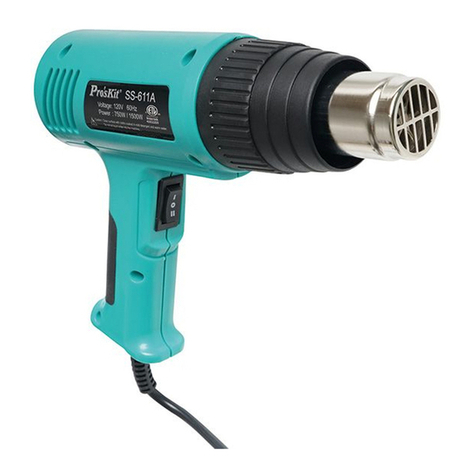
Pro's Kit
Pro's Kit SS-611A user manual
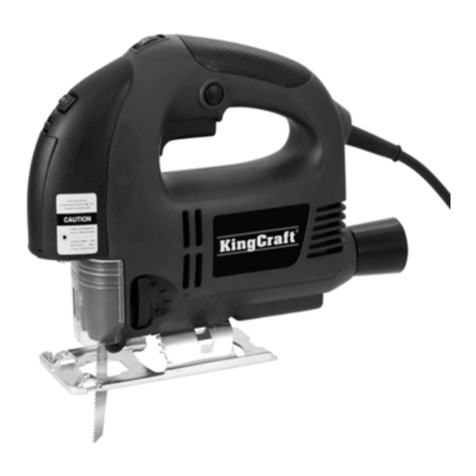
KING CRAFT
KING CRAFT MIQ-FE-65 instruction manual

Traditional Tool Repair
Traditional Tool Repair P330 Operation manual & spare parts list
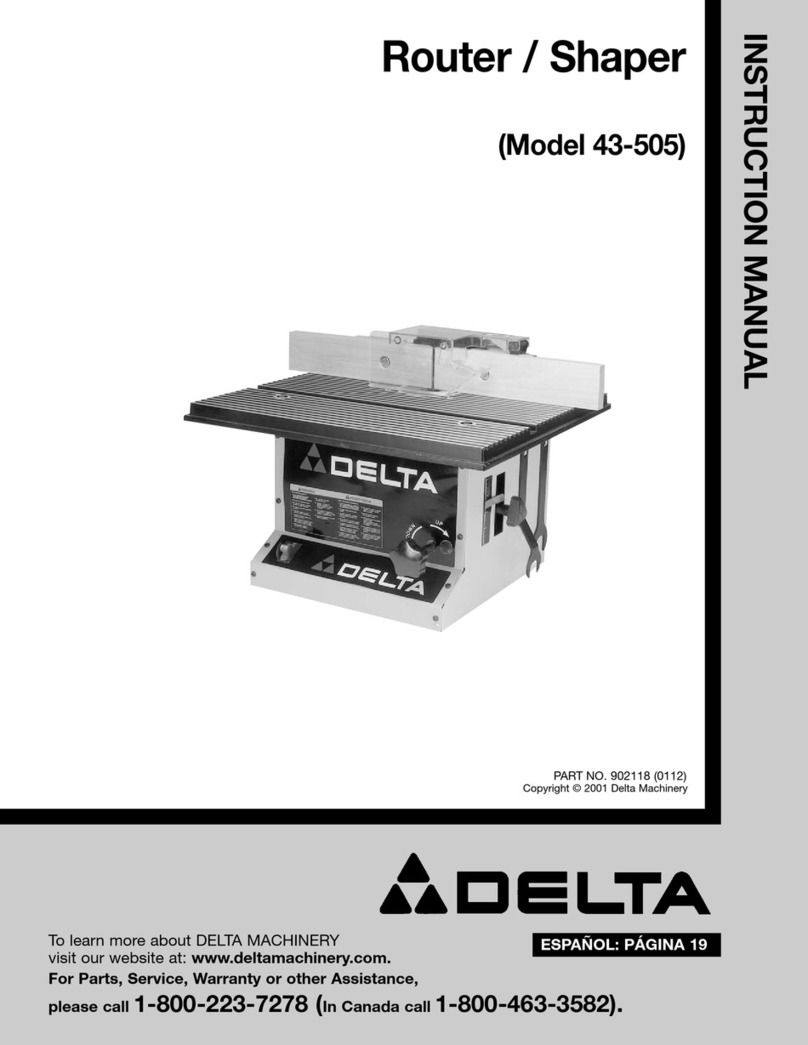
Delta
Delta 902118 43-505 instruction manual

FLORABEST
FLORABEST FAA 79 A1 quick start guide
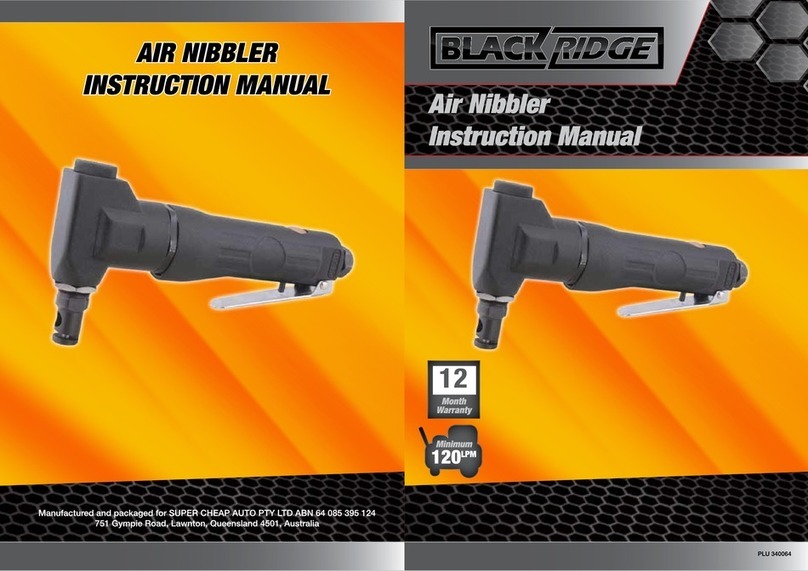
Black Ridge
Black Ridge WFX-1503A instruction manual
